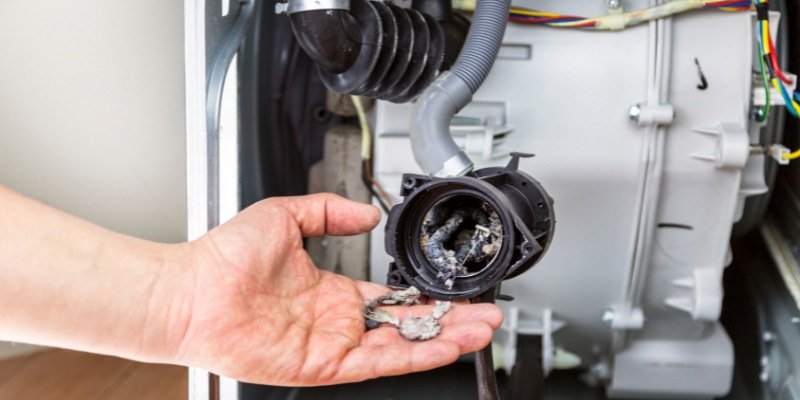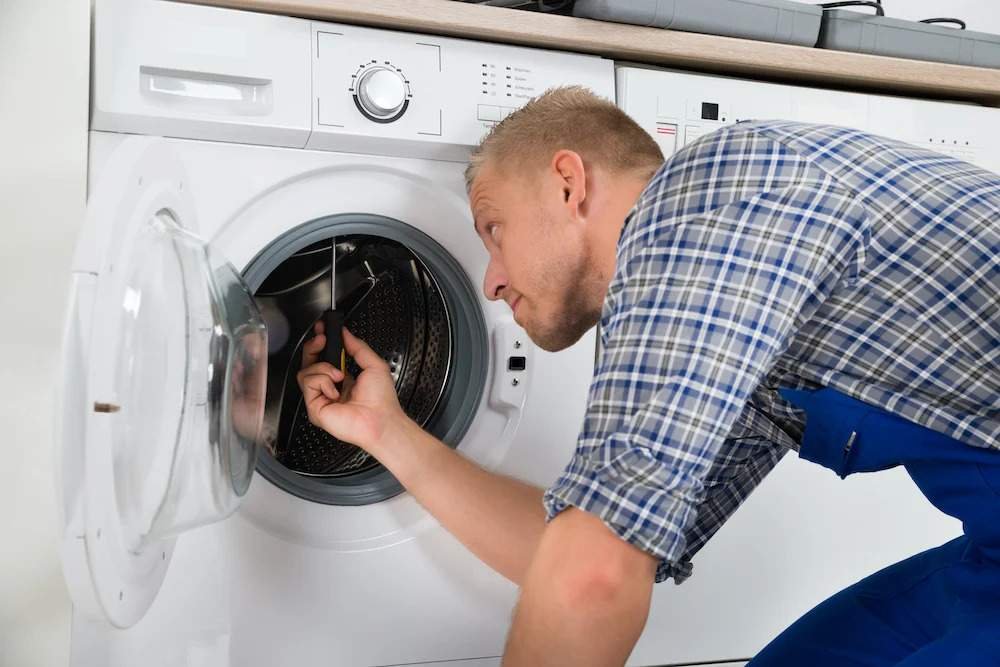Alhambra residents! Dealing with pesky washing machine drain issues? Don’t fret, because The Pro Plumbing is here to help you troubleshoot and tackle these problems like a pro! From water not draining properly to mysterious leaks, we’ve got you covered with practical tips and tricks to get your washing machine back in action. Say goodbye to standing water and soggy laundry days by following our expert advice tailored specifically for Alhambra homes. Let’s dive in and make laundry woes a thing of the past!
Common Causes of Washing Machine Drain Problems
Clogged Drain Hose:
One of the most frequent culprits behind washing machine drainage issues is a clogged drain hose. Over time, debris, lint, and detergent residue can accumulate in the hose, restricting water flow and leading to slow draining or complete blockages.
Blocked Pump Filter:

The pump filter in your washing machine is designed to trap debris and prevent it from entering the drainage system. However, if the filter becomes clogged with lint, hair, or foreign objects, it can impede water drainage and cause backups.
Improper Installation:
In some cases, washing machine drain problems stem from improper installation. If the drain hose is not positioned correctly or is kinked, it can prevent water from flowing out smoothly, resulting in drainage issues.
Drain Pipe Obstructions:
Drain pipe obstructions can lead to washing machine drainage problems. Consider professional fixing pipes services to address issues such as blockages, leaks, or damaged pipes. These services can effectively clear obstructions in the drain pipe, ensuring smooth water flow and preventing backups or flooding. Regular maintenance and prompt repairs by experienced professionals can help maintain the integrity of your plumbing system and prevent costly water damage.
Pump Malfunction:
A malfunctioning drain pump can significantly impact the draining process. If the pump fails to expel water effectively, it can cause slow drainage, water pooling in the machine, or even complete drainage failure.
Now that we’ve identified the common causes, let’s move on to the troubleshooting steps you can take to resolve washing machine drain problems in your Alhambra home.
Troubleshooting Steps for Washing Machine Drain Problems
Step 1: Check the Drain Hose
Start by inspecting the drain hose connected to your washing machine. Follow these steps:
- Turn off the washing machine and unplug it from the power source for safety.
- Locate the drain hose at the back of the machine. It’s usually a flexible tube made of rubber or plastic.
- Check for any visible kinks, twists, or bends in the hose that may be restricting water flow.
- Remove the hose from the drain pipe or standpipe and inspect it for clogs or debris. You can do this by blowing through the hose or using a flashlight to look inside.
- If you notice any blockages, carefully remove them using a pipe cleaner, wire hanger, or a small brush. Be gentle to avoid damaging the hose.
Once you’ve cleared any obstructions and ensured that the hose is free of kinks, reattach it securely to the drain pipe or standpipe.
Step 2: Clean the Pump Filter
Cleaning the pump filter is essential for maintaining proper drainage in your washing machine. Additionally, consider professional drain cleaning services to ensure optimal functionality. These services can address blockages, obstructions, and buildup in the drain pipe and trap, preventing future drainage issues and promoting efficient water flow.
- Refer to your washing machine’s user manual to locate the pump filter. It’s usually located at the front or bottom of the machine behind a small access panel.
- Place a shallow pan or towel beneath the access panel to catch any water or debris that may spill out.
- Unscrew or remove the panel covering the pump filter. Use caution, as there may be water inside.
- Once the filter is accessible, carefully remove it and inspect it for lint, hair, and other debris. Clean the filter thoroughly using warm, soapy water and a soft brush.
- Rinse the filter with clean water to remove any soap residue, then reinsert it back into place and secure the access panel.
Cleaning the pump filter regularly can prevent clogs and ensure optimal drainage performance.
Step 3: Check the Drain Pipe
After addressing the drain hose and pump filter, it’s essential to inspect the drain pipe for any obstructions. Follow these steps:
- Locate the drain pipe where it connects to the main plumbing system or standpipe.
- Remove the drain pipe from its connection point and inspect it for clogs or buildup. You can use a flashlight to look inside and a pipe cleaner or wire brush to remove any debris.
- If you encounter stubborn clogs or mineral buildup, consider using a plumbing snake or auger to clear the blockage effectively.
- Once the drain pipe is clear, reattach it securely to its connection point and ensure there are no leaks.
Step 4: Check for Pump Malfunction

If you’ve checked the drain hose, pump filter, and drain pipe and are still experiencing drainage issues, there may be a problem with the drain pump itself. Here’s how to troubleshoot pump-related problems:
- Listen for unusual noises coming from the washing machine during the draining cycle. Grinding, humming, or rattling sounds could indicate a malfunctioning pump.
- Check the pump for visible signs of damage, such as cracks, leaks, or loose connections. If you notice any issues, it’s best to consult a professional plumber or appliance repair technician for further diagnosis and repair.
- Test the pump by running a drain cycle with no laundry in the machine. Observe whether the water drains properly and if the pump operates smoothly without excessive noise or vibration.
If you suspect a pump malfunction, it’s crucial to address it promptly to prevent further damage to your washing machine.
Step 5: Ensure Proper Installation
Ensuring proper installation of your washing machine is crucial to avoid drainage issues. Consider professional sewer repair services to address any installation-related problems, such as improper drain pipe positioning or ventilation issues. These services can help optimize your plumbing system, prevent water backups, and ensure efficient water drainage from your washing machine.
- Make sure the drain hose is positioned correctly and securely attached to the drain pipe or standpipe. Avoid kinks or bends that can restrict water flow.
- Check the height of the drain hose relative to the washing machine. Ideally, the hose should be elevated at least 3 feet above the floor to prevent water from siphoning back into the machine.
- Verify that the drain pipe has adequate ventilation and is not blocked by debris or obstructions. Proper ventilation allows for smooth water flow and prevents airlocks in the drainage system.
- If you’re unsure about the installation or encounter persistent drainage issues, consider consulting a professional plumber or appliance technician for expert assistance.
By following these troubleshooting steps and ensuring proper installation, you can effectively address washing machine drain problems in your Alhambra home and restore optimal performance to your laundry routine.
Additional Tips for Preventing Washing Machine Drain Problems
In addition to regular maintenance, consider the role of professional drain cleaners in preventing washing machine drain problems. These experts can perform thorough inspections, identify potential issues, and clear any buildup or blockages in your plumbing system. By addressing these concerns proactively, professional drain cleaners help prevent plumbing emergencies, such as water backups or flooding, ensuring smooth water flow and optimal performance from your washing machine.
Use High-Efficiency Detergent:
Opt for high-efficiency (HE) detergents specifically designed for modern washing machines. These detergents produce fewer suds and reduce the likelihood of residue buildup in the drain hose and pump filter.
Regular Maintenance:
Incorporate regular maintenance tasks into your laundry routine, such as cleaning the pump filter, inspecting the drain hose for clogs, and checking the drain pipe for obstructions. This proactive approach helps prevent major drainage issues.
Avoid Overloading:
Overloading your washing machine can strain the drain pump and lead to drainage problems. Follow the manufacturer’s guidelines regarding load capacity to ensure proper water drainage and optimal machine performance.
Monitor Water Pressure:
Fluctuations in water pressure can affect your washing machine’s ability to drain effectively. Keep an eye on water pressure levels and address any issues promptly to prevent drainage problems.
Install a Drainage Standpipe:
If your washing machine drains into a standpipe, ensure it is installed correctly and at the recommended height. A properly installed standpipe prevents water backups and promotes efficient drainage.
FAQs
Why is my washing machine having trouble draining?
Your washing machine may be having trouble draining due to several reasons. Common causes include a clogged drain hose or pump filter, improper installation leading to kinks or blockages, and potential malfunctions in the drain pump itself. Regular maintenance and troubleshooting can help identify and resolve these issues to ensure proper drainage.
Why is my washing machine trap not draining?
Your washing machine trap may not be draining due to a blockage or clog in the trap itself. This can happen if debris, lint, or other materials accumulate and obstruct the flow of water. Cleaning the trap regularly and removing any obstructions can help restore proper drainage.
How do I check my washing machine drain?
To check your washing machine drain, start by inspecting the drain hose for any kinks, twists, or blockages. Next, remove and clean the pump filter to ensure it’s not clogged with debris. Finally, check the drain pipe and trap for obstructions or buildup that may impede water flow, and clear any blockages if necessary.
Why is my washing machine not draining?
Your washing machine may not be draining and causing flooding due to several possible reasons. This could include a clogged drain hose or pipe, a malfunctioning drain pump, or an issue with the machine’s internal drainage system. It’s crucial to address these issues promptly to prevent water damage and restore proper functioning to your washing machine.
How do I force my washing machine to drain?
To force your washing machine to drain, first, turn off the machine and unplug it from the power source for safety. Next, locate the drain hose and carefully disconnect it from the drain pipe or standpipe. You can then manually drain the water by lowering the hose into a bucket or sink positioned lower than the machine, allowing gravity to assist in draining the water.
Conclusion
Troubleshooting washing machine drain problems in Alhambra homes requires a combination of proactive maintenance, effective troubleshooting techniques, and, if necessary, professional assistance. By understanding the common causes, signs, and prevention tips outlined in this guide, you can address drainage issues promptly and maintain optimal performance from your washing machine.
Remember to regularly clean the pump filter, inspect the drain hose and pipe for clogs, avoid overloading, and monitor water pressure to prevent drainage problems. If issues persist or you encounter complex issues, don’t hesitate to contact a qualified professional for expert assistance.
With the right knowledge and proactive approach, you can keep your washing machine running smoothly and enjoy hassle-free laundry days in your Alhambra home.





